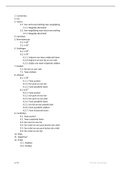Resumen
Summary Thema 7: alle matrixen!
- Grado
- Institución
Op aanraden van mijn medestudenten verkoop ik nu mijn samenvattingen! In deze samenvatting maak ik veel gebruik van afbeeldingen, tabellen en opsommingen. Hierdoor hoef je geen lange lappen saaie en ingewikkelde tekst te lezen. In deze samenvatting staat alle stof van de boeken, colleges en leerdoe...
[Mostrar más]






